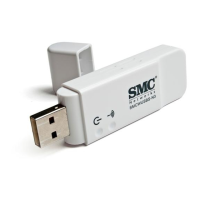G
LOSSARY
– 46 –
INFRASTRUCTURE An integrated wireless and wired LAN is called an infrastructure
configuration.
LAN Local Area Network: A group of interconnected computer and support
devices.
MAC ADDRESS The physical layer address used to uniquely identify network nodes.
NTP Network Time Protocol: NTP provides the mechanisms to synchronize time
across the network. The time servers operate in a hierarchical-master-
slave configuration in order to synchronize local clocks within the subnet
and to national time standards via wire or radio.
OPEN SYSTEM A security option which broadcasts a beacon signal including the access
point’s configured SSID. Wireless clients can read the SSID from the
beacon, and automatically reset their SSID to allow immediate connection
to the nearest access point.
ODFM Orthogonal Frequency Division Multiplexing: OFDM allows multiple users to
transmit in an allocated band by dividing the bandwidth into many narrow
bandwidth carriers.
ROAMING A wireless LAN mobile user moves around an ESS and maintains a
continuous connection to the infrastructure network.
RTS THRESHOLD Transmitters contending for the medium may not be aware of each other.
RTS/CTS mechanism can solve this “Hidden Node Problem.” If the packet
size is smaller than the preset RTS Threshold size, the RTS/CTS mechanism
will NOT be enabled.
SSID Service Set Identifier: An identifier that is attached to packets sent over
the wireless LAN and functions as a password for joining a particular radio
cell; i.e., Basic Service Set (BSS).
SHARED KEY A shared key can be used to authenticate each client attached to a wireless
network. Shared Key authentication must be used along with the 802.11
Wireless Equivalent Privacy algorithm.
SNMP Simple Network Management Protocol: The application protocol in the
Internet suite of protocols which offers network management services.

